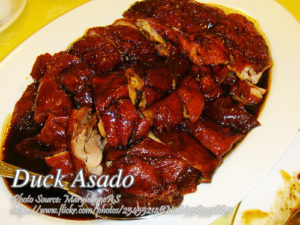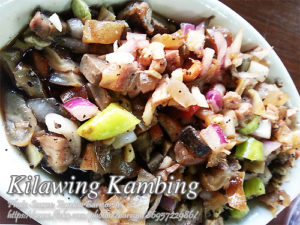Pork caldereta is the pork version of the well known beef caldereta. Although there are many kind of caldereta in Filipino cuisine that make use of goat meat, duck or chicken meat. This is a Filipino tomato based stew which you can use either tomato sauce, tomato paste or fresh tomatoes. Cooking this this involves sauteing the pork with garlic, onions and tomatoes until the meat is brown. So why still use fresh tomatoes since we are already using tomato sauce?
This will add more flavor to the meat since you are also browning it first. As much as possible don’t omit the green olives since it gives a distinct sour flavor to the dish. But since they are expensive, you can use pickles as an alternative. Liver spread is essential because it will not be a caldereta dish without the liver spread. But if you really can’t find liver spread, as an alternative, and I think it is better, is broiling a piece of pork liver and chop it finely.
What Makes Pork Caldereta a Filipino Favorite?
If you’ve ever been to a Filipino gathering, you’ll know caldereta is a must-have dish. Traditionally made with beef or goat, this comforting stew comes alive with tender pork, savory tomato flavors, and a unique blend of spices. Kalderetang baboy is a perfect option for those who want the hearty taste of caldereta without the long cooking time often needed for beef. My auntie Lita first introduced me to this dish, and it quickly became a family favorite. Her version, like many others in our family, is both flavorful and easy to prepare, making it a great starting point for beginners and a nostalgic bite for seasoned cooks.
A Taste of Filipino Tradition with Pork Caldereta
Caldereta is believed to have roots in Spanish cuisine, brought to the Philippines during the colonial period, and adapted over generations with ingredients native to the islands. While the traditional beef or goat version is common, many Filipinos, especially in areas where pork is more affordable, created their own variations. Pork caldereta, or kalderetang baboy, captures the same deep, comforting flavors of its beef counterpart but has a slightly quicker cook time, making it an ideal choice for weeknight dinners.
This tomato-based pork stew uses ingredients like garlic, onions, and tomatoes that are staples of Filipino cooking. But what sets this dish apart are the subtle additions of liver spread and green olives, which lend a depth and complexity of flavor to the dish that keeps you coming back for more. I still remember how my cousin Carla would insist on adding olives—she swears it’s what gives caldereta that signature kick!
Essential Ingredients That Bring Out the Flavor
Pork caldereta shines because of the way ingredients are layered and cooked. Each addition brings a distinct taste and texture that makes the stew rich and unforgettable. When you begin by browning the pork with garlic, onions, and fresh tomatoes, this base layer adds a depth to the flavor of the pork. Although we’re using tomato sauce, fresh tomatoes bring a slightly acidic sweetness that intensifies as the pork browns, giving a rich foundation to the stew.
Adding liver spread is essential; it gives caldereta its signature flavor and creamy texture. If you can’t find liver spread, broiling a piece of pork liver, then finely chopping it, can offer an equally delicious result. My uncle Roberto, who’s a stickler for tradition, always says caldereta without liver is like sinigang without tamarind—it just doesn’t taste the same!
Another classic addition is green olives, which add a distinct, tangy edge that enhances the savory flavors. While olives can be pricey, you can substitute them with pickles, which will also bring a touch of tartness, although my Lola Nena insists that nothing quite compares to olives for that authentic taste.
Cooking Tips for a Perfect Pork Caldereta
Cooking pork caldereta is all about patience and building layers of flavor. Start by sautéing the garlic until it’s aromatic, then add onions and tomatoes, allowing each ingredient to release its flavors fully. You’ll notice the oil turning a slight orange color when the tomatoes are cooked perfectly, which is an ideal base for the pork. Browning the pork until it has a golden crust brings out its natural flavors and ensures a rich taste in every bite.
After browning, adding water helps tenderize the pork as it simmers. Midway through cooking, the liver spread, pork cubes, and patis (Filipino fish sauce) are added, blending umami with the natural sweetness of the tomato sauce. The simmering time is key—it allows the flavors to meld together into a balanced stew, with tender pork and a sauce thickened by liver spread.
For the final touches, add in carrots, potatoes, olives, and chili peppers. Each vegetable needs enough cooking time to absorb the flavors without becoming mushy. Finally, bell peppers go in last, ensuring they stay slightly crisp and colorful. My sister, Mina, always saves this step for last because she says it makes the dish look extra vibrant on the table.
A Dish Best Served with Rice
Kalderetang baboy is a quintessential ulam that pairs perfectly with a side of rice to soak up the rich sauce. In our family, steamed rice is the go-to, though occasionally we indulge with garlic fried rice for an extra burst of flavor. The combination of the savory stew with the rice brings back memories of family gatherings and festive meals.
Why You’ll Love Making Pork Caldereta
This pork dish may sound complex, but it’s a forgiving dish that’s perfect for beginner cooks and a favorite for anyone craving a rich, comforting meal. The mix of ingredients comes together into a hearty, flavor-packed stew that’s uniquely Filipino. Each step—from sautéing the aromatics to simmering the stew—builds a depth of flavor that’s hard to resist.
Not only does it bring a bit of Filipino history to your kitchen, but it also offers a taste of home for anyone familiar with Filipino cuisine. Even if you’re new to cooking Filipino dishes, kalderetang baboy is a fantastic way to start, giving you a delicious taste of tradition with every spoonful.
How To Cook Pork Caldereta (Kalderetang Baboy)
Ingredients
- 1/2 kilo pork belly or pork shoulder cut into cubes
- 1 cup tomato sauce (200ml pack)
- 1/2 cup green olives or sliced pickles (optional)
- 2 pcs tomatoes chopped
- 1 pc red onion chopped
- 3 cloves garlic minced
- 1 green bell pepper sliced
- 1 red bell pepper sliced
- 2 pcs red chili peppers sliced (optional)
- 2 pcs medium sized potatoes (or 1 large potato) cut into cubes
- 1 pc medium sizecarrot sliced
- 1 pork bouillon (e.g. Knorr pork Cube) pork cube
- 2 pcs bay leaves
- 1/2 tsp. ground black pepper
- 1/2 cup liver spread
- 4 cups water
- 3 Tbsp. cooking oil
- 1 Tbsp. patis or adjust to suit your taste
- pepper to taste
Instructions
How To Cook Pork Caldereta (Kalderetang Baboy):
- In a medium size wok, heat oil and saute garlic until fragrant. Then add onions and stir until soft.
- Add in tomatoes and stir cook until it becomes soft and the oil turns to orange in color.
- Then add the pork belly and saute for about 4 minutes or until the pork turns to brown.
- Pour in water and add black pepper then simmer in medium heat for about 30 minutes and cover.
- Add the patis, liver spread, and pork cubes. Mix until the liver spread is well combined with the liquid.
- Add the tomato sauce and bay leaves. Mix again to combine. Then cover and simmer for about 20 minutes more.
- Then add carrots, potatoes, olives and chili peppers (optional). Mix and cover then simmer for 7 minutes.
- And for the finale, add the in the bell peppers, cover and simmer again for 3 minutes.
- Serve hot with steamed rice or fried rice.
Video
Notes
Cooking Tips:
Brown the Pork for Extra Flavor
Browning the pork before simmering deepens the flavor and adds a rich, savory base to the dish. Make sure to sauté the pork until golden brown on all sides, allowing a light crust to form. This step not only locks in juices but also enhances the overall taste of the caldereta.Use Both Fresh Tomatoes and Tomato Sauce
Combining fresh tomatoes with tomato sauce creates a layered depth in flavor that’s essential for a well-rounded stew. Sauté the fresh tomatoes first until they soften and release their natural sweetness, then add tomato sauce to thicken. This approach balances acidity and sweetness, making the stew’s sauce richer and more vibrant.Don’t Skip the Liver Spread
Liver spread is key to achieving the authentic, earthy flavor that defines caldereta. It also helps to thicken the sauce, adding richness and a unique depth to the dish. If you can’t find liver spread, broil a piece of fresh pork liver, chop it finely, and stir it in as a substitute.






Hi Arlene, I’m happy to know that cooking this recipe was a success! Thanks for visiting and sharing your comment!
Just tried this, but used 1.5 kg pork so adjusted some of the ingredients to taste, and used a whole can of Reno liver spread (because I LOVE liver spread). The result was fantastic! Thanks so much for posting this recipe. Will make again.
Tnx ! :))
Hi Lexy, I’m happy that you liked the recipe! Cheers!
Just followed this recipe and it taste so good! thank you!
what is peppercorn??
Hi lovelyn,
Peppercorn is also known as “paminta” or black pepper.